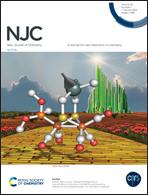A molecular electron density theory study for [3+2] cycloaddition reactions of N-benzylcyclohexylnitrone with methyl-3-butenoate
Abstract
The [3+2] cycloaddition (32CA) reactions of N-benzylcyclohexylnitrone 1 with methyl-3-butenoate 2 have been studied within molecular electron density theory (MEDT) at the B3LYP/6-311++G(d,p) level of theory. These zwitterionic type 32CA reactions occur through a one-step mechanism. The 32CA reactions undergo two pairs of stereo- and regioisomeric reaction paths to form four different products, 3, 4, 5 and 6. The reaction paths are irreversible due to the exothermic character of −18.5 and −12.4 kcal mol−1. The 32CA reaction leading to the formation of cycloadduct 3 presents the lowest activation enthalpy compared to the other path due to a slight increase in polar character evident from the global electron density transfer (GEDT) at the transition states and along the reaction path. The bonding evolution theory (BET) study suggests that these 32CA reactions occur through the coupling of pseudoradical centers and the formation of new C–C and C–O covalent bonds has not been started in the transition states.
![Graphical abstract: A molecular electron density theory study for [3+2] cycloaddition reactions of N-benzylcyclohexylnitrone with methyl-3-butenoate](/en/Image/Get?imageInfo.ImageType=GA&imageInfo.ImageIdentifier.ManuscriptID=D0NJ04049E&imageInfo.ImageIdentifier.Year=2021)


 Please wait while we load your content...
Please wait while we load your content...